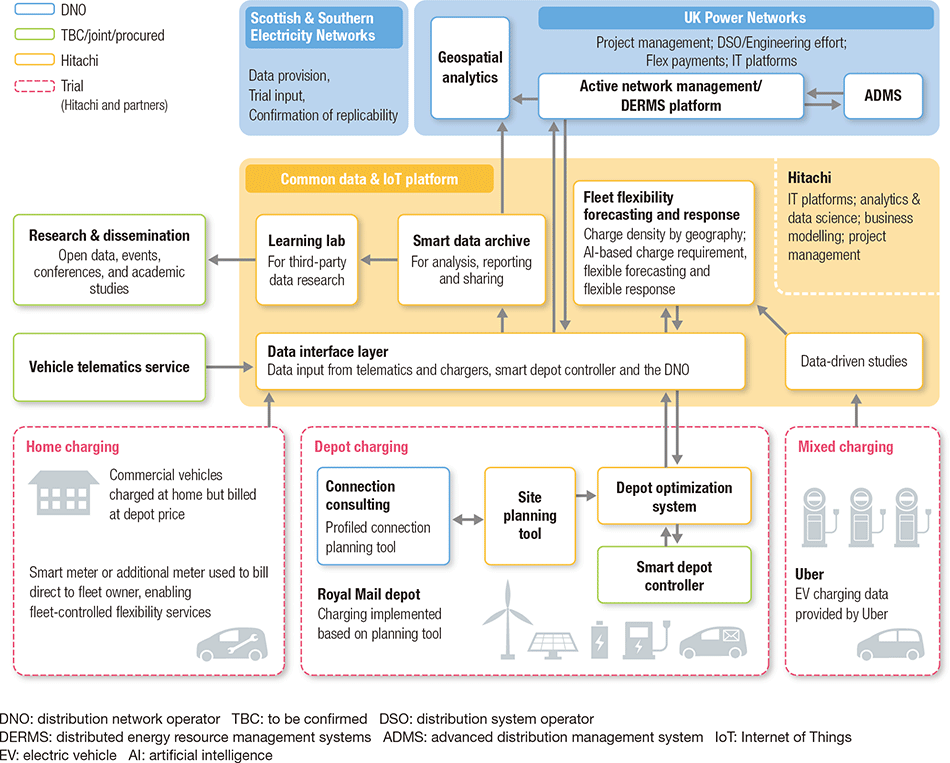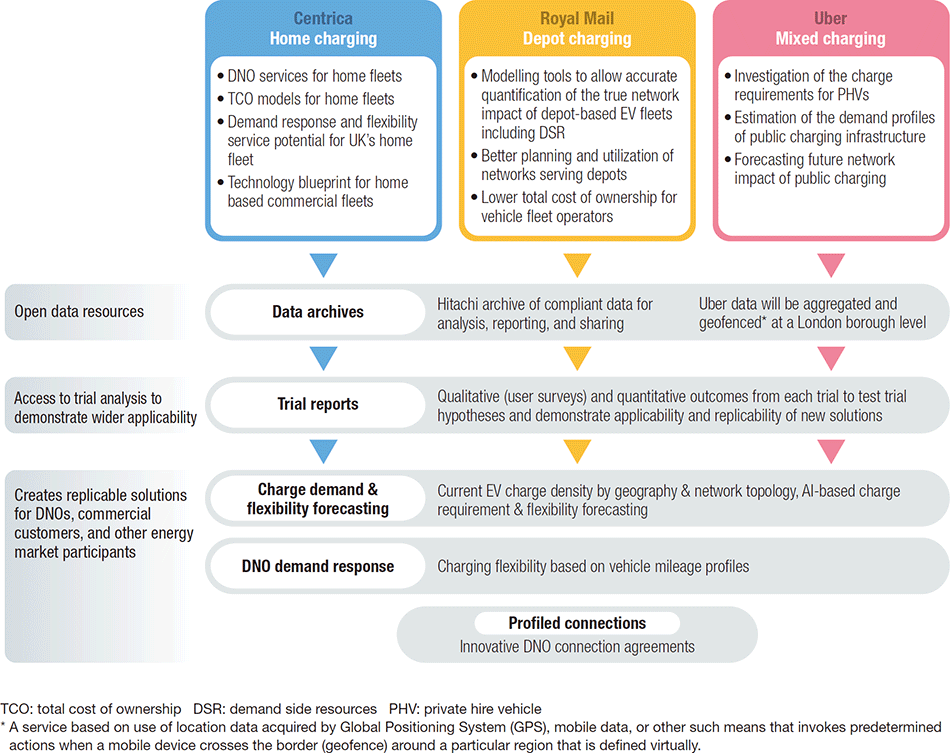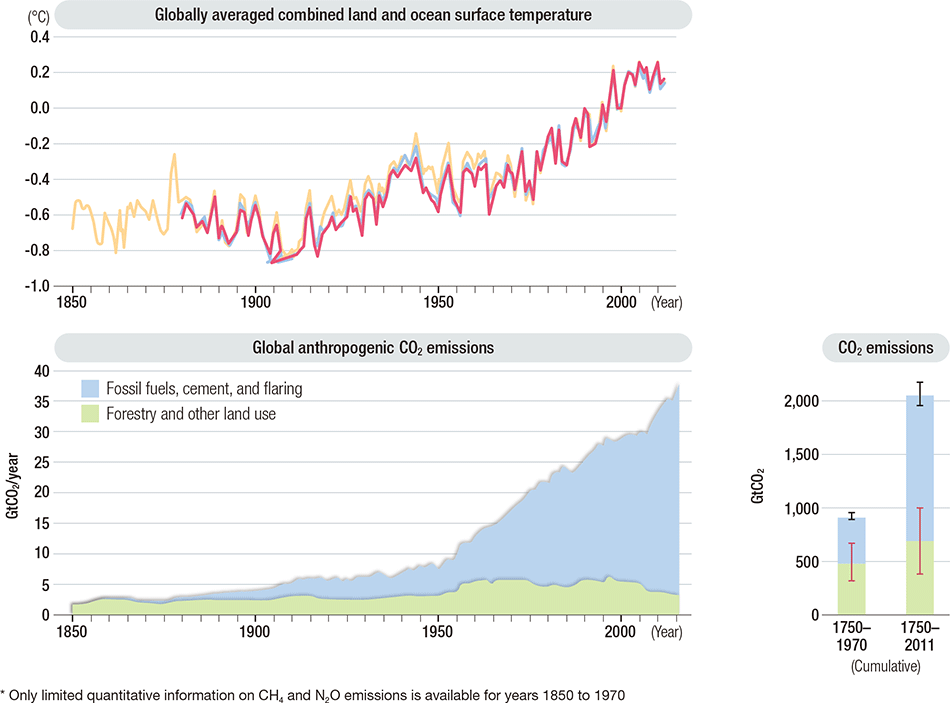COVER STORY:ACTIVITIES 2Co-Creating Sustainable Solutions to Optimize Energy ResourcesHelping the UK Meet Climate Change Objectives as They Prepare for the Mass Adoption of Electric Vehicles
Highlight
While energy has helped improve the quality of life for billions of people around the world, the effect of human influence has profoundly impacted the climate. Along with economic progress and population growth, the rapid pace of globalization has led to the highest levels of greenhouse gases in history. However, innovations and investments in environmentally sound infrastructure and technology can significantly reduce greenhouse gas emissions and enhance resilience to climate change. One key strategy is to transition vehicles away from the internal combustion engine to ultra-low to zero-carbon technology. To help the UK prepare for the mass adoption of electric vehicles, Hitachi Group including Hitachi Vantara Limited leads a project consortium called Optimise Prime. This is a £35-million study into the impact of commercial electric vehicles on the electricity grid.

Impact of Energy Consumption on the Climate
According to the World Meteorological Organization’s consolidated analysis of leading international datasets, average temperatures for the five-year (2015-2019) and ten-year (2010-2019) periods were the highest on record(1). Since the 1980s, each decade has been warmer than the previous one and this trend is expected to continue because of record levels of heat-trapping greenhouse gases in the atmosphere. The main human activity that emits carbon dioxide (CO2) is the combustion of fossil fuels (coal, natural gas, and oil) for energy (the combustion of fossil fuels to generate electricity to power homes, business and industry) and transportation (combustion of fossil fuels such as gasoline and diesel to transport people and goods) (see Figure 1).
Continued emission of greenhouse gases will cause further warming and long-lasting changes in all components of the climate system, increasing the likelihood of severe, pervasive, and irreversible impacts for people and ecosystems. Substantial emissions reductions over the next few decades can reduce climate risks. One of the most effective ways to reduce CO2 emissions is to reduce fossil fuel consumption by driving the efficient use of energy resources.
Along with economic progress, the rapid pace of globalization is confronting the world with a variety of challenges while also creating new opportunities to disrupt and innovate. Today, the energy industry is transforming as it seeks to address environmental and safety regulations, reduce energy use and operational costs, lower carbon emissions, and support overall Sustainable Development Goals (SDGs).
Helping the UK Reach Carbon Reduction and Electrification Goals
More and more countries around the world are making commitments to reduce CO2 emissions and cut levels of other harmful pollutants in cities, but nowhere in the world has championed renewable energy more actively than the European Union (EU). And as the region works to adopt large-scale renewable energy, problems such as shortages of power transmission facilities and grid instability have been coming to light.
The EU set a target for 20% of EU primary energy to come from renewable sources by 2020. Due to the difficulty of providing economical renewable heating and transportation, a large majority of this energy needs to come from renewable electricity generation. However, the integration of this quantity of renewable generation into an existing electricity system presents significant challenges.
For the UK to meet a legally binding target of an 80% reduction in carbon emissions by 2050, most models suggest a virtually decarbonized electricity sector by 2030. According to the Committee on Climate Change, for the UK to meet its climate change objectives by 2030, 60% of new vehicles on the road need to be powered by electricity(2). But to accomplish this, the UK needs to make big changes in the way it gets electricity to consumers and businesses. Today, the electricity distribution network is not prepared to deal with electricity demands on an industrial scale in areas zoned for residential and commercial use.
It is against this background that a partnership of eight companies has embarked on a London-based project that seeks to encourage wider adoption of electric vehicles (EVs) and leverage existing grid infrastructure while also reducing electricity bills (see Figure 2). Along with Hitachi Vantara Limited, the project participants are Hitachi Europe Ltd.; Hitachi Capital Corporation; UK Power Networks Holdings Limited and Scottish & Southern Electricity Networks, both electricity distributors; Centrica PLC, a major gas and electricity company that operates a large fleet of service vehicles for the maintenance of domestic heating and other such equipment; Royal Mail Group PLC; and Uber Technologies Inc., the rapidly growing ride sharing operator.
Named Optimise Prime, the project intends to undertake trials over the coming three years for which it has received funding from the UK Office of Gas and Electricity Markets (Ofgem)(3). This funding was obtained through Ofgem’s Network Innovation Competition (NIC) project selection process and recognizes Optimise Prime as one of a number of demonstration projects aimed at fostering profitable innovation across all UK electricity transmission and distribution operators as they work toward achieving a low-carbon society.
With over 100 years of business experience and technology, Hitachi adheres to social, environmental, and economic values to co-create solutions to societal problems on a global scale. Hitachi Europe is managing the delivery of the program and developing specialist fleet tools and Hitachi Capital is contributing in-depth knowledge of the fleet and leasing sector. Hitachi Vantara, meanwhile, is the commercial lead and is providing the Internet of Things (IoT) platform, data management, and analysis expertise to the project.
Optimise Prime will monitor the behavior of up to 3,000 commercial EVs operated by partner companies and investigate how data and optimization technologies can mitigate challenges and accelerate the rollout of EVs and low-carbon transportation while minimizing the costs for bill payers. This project aims to create a detailed understanding of the impact of commercial EVs on power networks. To generate insights and solutions, the program is running several trials to answer three core questions:
- How best to quantify and minimize the impact of commercial EVs on the network?
- What is the value proposition of smart solutions for EV fleets and private hire vehicle (PHV) operators?
- What infrastructure (network, charging, and IT) is needed to enable the EV transition?
Effect of Carbon Reduction Efforts on Electric Distribution Networks
Road transportation currently contributes around 27% of UK domestic CO2 emissions. While overall carbon emissions across the UK economy fell by 38% between 1990 and 2017, emissions from the transportation sector fell by only 0.7%(2). The parcel delivery and private hire vehicle sectors, meanwhile, have seen significant increases in CO2 emissions due to rising demand driven by growth in online shopping and a reduction in car ownership.
While the move to EVs helps reduce CO2 emissions, it also has a significant impact on electric distribution networks. Without a smart approach to planning and operating new EV infrastructure, the resulting inefficiencies in asset utilization and operation will lead to higher costs for consumers and businesses while also delaying the transition.
To address these societal challenges around commercial vehicles, Optimise Prime is focusing on the business challenges faced by distribution network operator (DNO) partners.
The uptake of EVs is expected to pose substantial challenges to electricity networks, and while DNOs are aware of the potential demand that may be caused by EVs, they lack the data necessary to forecast and plan their future investments effectively. Studies have estimated that 32% of the power lines supplying home and businesses in the UK will require upgrade once EV adoption reaches 40-70% of the population. DNOs have a responsibility to ensure that everyone receives a reliable electricity supply and they must also ensure that the costs of meeting the additional demand from EVs is budgeted and managed effectively.
Noting that commercial organizations purchase 58% of new vehicles in the UK and replace them on regular cycles, and that the average mileage of commercial EVs is typically higher than domestic vehicles, Optimise Prime will focus on commercial vehicle fleets and private hire operators. This reflects the expectation that the shift to EVs will take place earlier for commercial vehicles and in ride-share services than it will for private vehicles. Furthermore, government surveys estimate an average annual light commercial vehicle mileage of 13,000 miles compared to 7,800 for cars (equating to a two-thirds-higher energy requirement), meaning that commercial vehicles offer greater opportunities for reducing operating costs by taking advantage of the low cost of electricity compared to petrol and diesel. However, this will also result in higher peak loads for the network.
From the perspective of vehicle operators, the move from internal combustion engine vehicles to electric is a significant shift in their operational processes. Charging takes much longer than filling a vehicle and currently available EVs must be charged more frequently. Infrastructure needs to be put in place to be able to charge many vehicles simultaneously. This brings costs in terms of infrastructure, energy, and operational processes that must be considered when determining the total cost of ownership of an EV.
While smart charging technologies exist in the market, designing energy systems and specifying connection capacities is a complex and specialized task that fleet and private hire operators are often not able to carry out. Ongoing optimization is required to minimize energy costs while considering a range of variables. These include number of EVs, mileage, operational characteristics, other sources of energy demand, opportunities for renewables and storage, value streams from demand response, physical site constraints, connection costs, asset financing, and return on investment.
As fleet and PHV operators are not well-equipped to determine the optimal connection from their DNO, they may over-specify their network connection requirements, resulting in poor electricity network utilization and unnecessarily high infrastructure costs.
How Innovation and Technology Can Drive Effective Use of Energy Resources
Fig. 3|Overview of Optimise Prime Demonstration Project
Fig. 4|Trial Process for Three Commercial or Hire Fleet Operators
With little information currently available to help DNOs plan their future investments efficiently, a multi-disciplinary approach is needed to create a detailed understanding of the influence of commercial EVs and their impact on the power network.
Given the power demands that an influx of EV technology will have on the pre-existing electric distribution network infrastructure, new complex solutions and strategies will need to be designed in order to manage charging and network capacity.
This will require a cross-industry approach to the design of sustainable solutions to scale that address the societal challenges of air quality, climate change, and security of energy supply.
Figure 3 shows an overview of the Optimise Prime demonstration project.
Optimise Prime will collect data from vehicles and chargers in order to monitor and forecast future charging behavior, thereby creating an unparalleled dataset that provides insights into the demands of commercial vehicle charging. Overlaid with data from the electricity networks, this will help to identify congestion and bottlenecks where mitigation needs to be targeted and will offer opportunities for expanding charging infrastructure. This will provide the quantitative information necessary to allow distribution networks to create more accurate demand forecasts, defer the need for network reinforcement, and plan their future investment effectively.
Beyond data analysis and forecasting, the project will also develop and trial new practical methods to better utilize existing network capacity and take advantage of the ability of fleets to change their charging behavior.
For commercial fleet and private hire operators, managing the cost of implementing and operating EV charging infrastructure is a key issue that Optimise Prime intends to address, helping vehicle operators to implement effective charging regimes in a way that does not result in an unacceptably high total cost of ownership.
The project has also looked at the two main forms of EV charging (at home or at the vehicle depot or public charging station) and identified how each of these present their own particular issues for both electricity network operators and fleet operators. Figure 4 shows the process used for this aspect of the project.
For at-home charging, Optimise Prime will trial solutions that separate electricity use in the home from that for work vehicle charging. This will allow people to benefit from negotiated electricity tariffs while also reducing the operational overheads associated with electricity billing. The solution will also allow the vehicles to participate in calls for flexibility from the DNO, creating an extra potential source of revenue for fleet managers.
For depot or public charging, Optimise Prime will develop a suite of depot tools that allow managers to plan the connection requirements of the depot, and for the DNO to offer a more flexible connection. Ongoing charging optimization will continue to consider vehicle schedules, power prices, and flexibility opportunities to reduce the cost of charging.
The complexities of Optimise Prime and its large and diverse group of partners presented a number of issues when getting the project established. The innovative nature of the project with its aim of trialing technologies on an unprecedented scale also introduces variables that must be managed. Hitachi Vantara led the process to bring together the eight project partners and has developed partnership agreements and governance frameworks that ensure all the partners contribute and effectively collaborate. The partners have used co-creation to develop a project scope that meets the future needs of the distribution networks while also addressing the challenges that electrification poses to commercial fleet and private hire operators.
Key to delivering this technology solution was the design and development of an IoT platform. To meet the needs of the consortium partners, this platform required the integration of existing charger, telematics, and vehicle data together with third-party data sources such as weather, calendar, and vehicle demand schedules. To support data analysis and forecasting activities in the project, the ingestion, cleansing, and storing of data in the big data innovation lab ensures that insights are available for use in future research while also providing the capability for access controls to ensure data security and meet the needs of commercial sensitivity and General Data Protection Regulation (GDPR) compliance.
The project involves working with partners who provide critical infrastructure services, such as power supply and guaranteed postal delivery, and careful planning was necessary so that day-to-day operational activities were not interrupted by the implementation and trialing of new technologies.
The platform enables energy specialists to explore project data, creating bespoke machine-learning-based forecasting and analysis models. By providing the ability to interface between DNO systems and charge points, the platform provides a detailed understanding of the available flexibility. The creation of the web-based site planning tool provides a simple interface for depot operators to input vehicle schedules, mileage, site energy profiles, and other constraints related to the depot allowing for the calculation of an optimal configuration of charging designed to minimize charging costs for the site. This tool provides depot managers with a way to keep track of their charging requirements and therefore to reduce the demand on the electricity distribution network when charging is not needed.
By considering vehicle demand, energy import tariffs, weather forecasts, and other relevant data, the depot optimization system calculates an optimal charge profile for each EV, also providing depots with a smart depot controller that can be used to control and optimize multiple charge points and any available energy resources such as batteries or solar (see Figure 5).
Transformational Impact of Optimise Prime
Launched in January 2019, the project will continue for a period of three or four years. In the early stages, Hitachi is designing the solution architecture and implementing the core IoT platform for the project. This platform is based around Hitachi Enterprise Cloud, Hitachi Content Platform, and Pentaho technologies and will enable the project to analyze data and deploy specialist applications. Hitachi will work closely with the other consortium partners to design a series of trials that will assess the effectiveness of new measures for facilitating the wider adoption of EVs.
EV data collection commenced in 2019, with a 12-month trial of up to 3000 vehicles planned to run from 2020 to 2022. In February 2023, a final report on the program’s activities will be released and made publicly available to provide other organizations, research programs, and policy makers with the data to enable their own zero-emission transitions through the adoption of EVs.
The benefits of Optimise Prime include:
- Transforming understanding of the effects of commercial EVs on electricity distribution networks in the first trial of its kind through the collection and analysis of the largest cross-industry dataset on commercial EV charging, with input from networks and fleets
- Demonstrating solutions for home and depot charging to show what is possible in large-scale electrification, thereby helping other fleet organizations with their own transformation
- Changing how fleet operators and other such businesses work with DNOs by building profiled connections and creating a process whereby DNOs can understand the potential impact on each customer and tailor their connection offering.
Initial business modelling has estimated savings of 2.7M tons of CO2 by 2030(4) were the methodologies being developed in Optimise Prime to prove successful and be implemented throughout Great Britain. This is equivalent to a jumbo jet aircraft flying around the world 1,484 times(5). Over the same period, it is estimated that £207M could be saved by UK network operators (and as a result by all electricity bill payers).
The energy industry is in the midst of a digital revolution, facing disruptions that range from the adoption of aggressive environmental policies and regulatory reform to the effects of climate change on energy grids. The actions and strategies taken today to reduce greenhouse gas emissions, limit temperature change, and drive the efficient use of energy resources will help to create climate-resilient pathways for global sustainable development, while at the same time helping to improve livelihoods, social and economic well-being, and effective environmental management.
While many industries are taking steps to reduce greenhouse gas emissions, no single option is enough by itself. By taking an integrated, cooperative, and well-designed systemic and cross-sectoral approach, however, and by combining this with the leveraging of innovation and investment in environmentally sound infrastructure and technologies, it will be possible both to reduce energy demand and enhance resilience to climate change.
REFERENCES
- 1)
- World Meteorological Organization
- 2)
- Committee on Climate Change : Reducing UK emissions 2018 Progress Report to Parliament (2018.6)(PDF, 5.9MB)
- 3)
- Office of Gas and Electricity Markets : Network Innovation Competition 2018, Optimise Prime(PDF, 7.1MB)
- 4)
- HM Government: The Clean Growth Strategy (2017.10)(PDF, 5.2MB)
- 5)
- Carbon Independent.org, “Based on Earth circumference at equator and 101g of CO2 produced per passenger per km flown” (viewed Jan. 2020)








